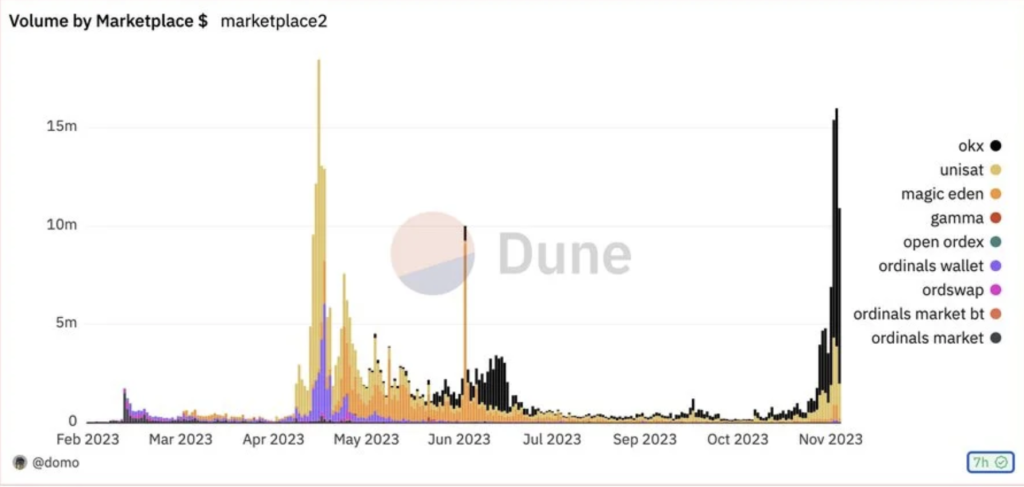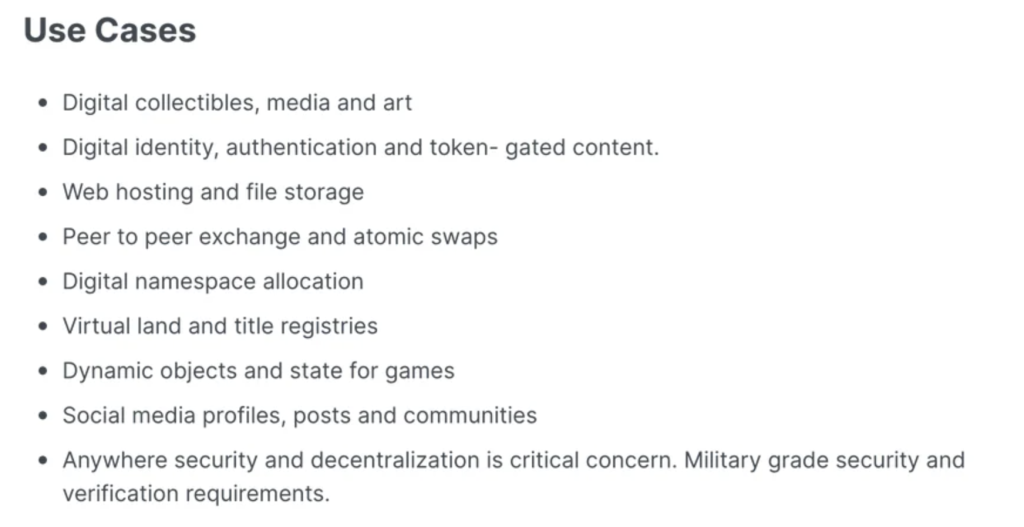Ordinals and BRC-20
In December 2022, Casey Rodamore introduced the Ordinals protocol . It assigns unique sequential numbers to each satoshi and tracks them in transactions. Anyone can attach additional data to a Satoshi through Ordinals, such as text, images, videos, etc.
The original concept was to allow people to store something on BTC, the most popular and powerful network eternal. Therefore, for some time, many considered Ordinals and “NFT on BTC” to be the same thing.
That all changed on March 8, 2023, when an anonymous developer named domo launched BRC-20 on Ordinals.

With the hype of BRC-20 in May-June and October-November, BRC-20 took up most of the Ordinals’ transaction volume, which was not liked Casey. He publicly stated that the BRC-20 brought a lot of garbage. Therefore, Casey and his team asked Binance to remove the reference to Ordinals from the description of the ORDI token, he does not want Ordinals and ORDI to be associated.
During the Singapore conference in September, someone, seemingly on their own, arranged for Casey and domo to meet at the same event. They say that when they met, they even greeted each other in a friendly manner.
Let's look at some projects of the BTC ecosystem
Trac-Tap-Pipe
After the appearance of BRC- 20, a developer named Beni appeared, who launched the following projects in 2023:
- Trac Core is a tool that combines the functions of an indexer and an oracle.
- TRAC is a token BRC-20 and also a governance token for Tap Protocol.
- Tap Protocol is an improved version of BRC-20 on Ordinals.
- TAP is a governance token for Pipe Protocol, released on based on Tap Protocol, it is no longer part of BRC-20 (but is still based on Ordinals). All 21 million TAP tokens are currently held by Beni, 0 in circulation;
- Pipe Protocol is an improvement based on Runes (more on this later) that is already beyond the scope of Ordinals.
Differences with BRC-20:
- 1) In Pipe, tokens can be transferred directly using utxo, and BRC-20 using two transactions. < li>2) BRC-20 tokens rely on centralized indexers, while Pipe relies on decentralized ones

All 21 million TAP tokens are currently held by Beni, 0 in circulation; there are -TAP tokens on the market, the first token on the Tap Protocol. In the future, the project plans to use TAP for financing and management, as well as allocate part of the tokens for airdrop to TRAC, -TAP and PIPE holders, specific numbers are still unknown.

As for Looksordinal, it is a tool for creating Inscriptions (does not have a token).

Useful links:
< a href="https://trac.network/" rel="nofollow" target="_blank">Website
Marketplace ;(to TRAC token)
Atomicals Protocol
In September, another anonymous developer released Atomicals Protocol.
At a basic level, Atomicals Protocol differs from Ordinals in that:
- Atomicals is based on UTXO BTC, 1 token = 1 satoshi, which is more consistent with Bitcoin technology without bringing additional network load, is technically more "conservative", more in line with BTC's technical aesthetic of maximalism;
- In comparison, Ordinals does not have a protocol for issuing tokens (which is why BRC-20 came along), but when the Atomicals Protocol was introduced, ARC-20 token standards and other use cases have already been defined.

Useful links:
Runes Protocol
As mentioned earlier, Casey does not like the BRC-20, believes that it brought too much garbage, polluting the Ordinals. Less than a week after the release of Atomicals, 26 September, Casey posted a tweet where he talks about a new idea: to create a homogeneous token protocol based on BTC called Runes
Runes is based on UTXO technology Casey believes that creating a good token protocol for Bitcoin can bring more funds. for transactions, more developers and users.
Shortly after the release of the Runes documentation, Beni (Trac Developer) saw an opportunity to introduce the Pipe protocol based on the Runes idea. The time for the official launch of Runes is still unknown. style="height: 4px; width: 4px;">
Is Inscriptions going to disappear?
Bitcoin Core developer Luke Dashjr posted a tweet in which he explained that Inscriptions exploit vulnerabilities to spam the blockchain by hiding their data in the form of program code, Inscriptions bypass this limitation. This bug was recently fixed in Bitcoin Knots v25.1. He hopes that this will be fixed next year, and also said that Ordinals are a scam and will most likely cease to exist after the fix. img src="/upload/medialibrary/bff/zl300k3rvfb46hsr2rlpqcz7j46phsnj.png">
If the Bitcoin network can't withstand measly spam from Inscriptions, how can we feel safe from an attack on the network? Over the last ten months, at least $121,386,535 in transaction fees have been paid for transactions.
Many logical questions have arisen for the developer, like: Why not leave them, because they are in demand, miners. They get more income and everyone is happy. To which Luke responded:
Bitcoin operates on the assumption that most miners should be happy with the profitability without such interference.
Many are skeptical about this, for example, Arthur Hayes simply sent it.

Conclusion
Project tokens after explosive growth began to fall by ~10-20%, a couple of hours after the Bitcoin Core developer’s tweet. Also, before the tweet, they started pumping the DOMO meme token (domo is the creator of BRC20), which grew almost 4 times.
It is unknown, even if the update that the Bitcoin Core developer is talking about comes out, whether it will affect only Ordinals or all (Atomicals Protocol, Pipe protocol and possible Runes).
It is interesting to watch the confrontation between projects in the race for hype.


